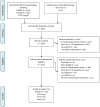Measures of vitamin K antagonist control reported in atrial fibrillation and venous thromboembolism studies: a systematic review
- PMID: 24951111
- PMCID: PMC4067815
- DOI: 10.1136/bmjopen-2014-005379
Measures of vitamin K antagonist control reported in atrial fibrillation and venous thromboembolism studies: a systematic review
Abstract
Objective: To aid trialists, systematic reviewers and others, we evaluated the degree of standardisation of control measure reporting that has occurred in atrial fibrillation (AF) and venous thromboembolism (VTE) studies since 2000; and attempted to determine whether the prior recommendation of reporting ≥2 measures per study has been employed.
Design: Systematic review.
Search strategy: We searched bibliographic databases (2000 to June 2013) to identify AF and VTE studies evaluating dose-adjusted vitamin K antagonists (VKAs) and reporting ≥1 control measure. The types of measures reported, proportion of studies reporting ≥2 measures and mean (±SD) number of measures per study were determined for all studies and compared between subgroups.
Data extraction: Through the use of a standardised data extraction tool, we independently extracted all data, with disagreements resolved by a separate investigator.
Results: 148 studies were included, 57% of which reported ≥2 control measures (mean/study=2.13±1.36). The proportion of time spent in the target international normalised ratio range (TTR) was most commonly reported (79%), and was frequently accompanied by time above/below range (52%). AF studies more frequently reported ≥2 control measures compared with VTE studies (63% vs 37%; p=0.004), and reported a greater number of measures per study (mean=2.36 vs 1.53; p<0.001). Observational studies were more likely to provide ≥2 measures compared with randomised trials (76% vs 33%; p<0.001) and report a greater number of measures (mean=2.58 vs 1.63; p<0.001). More recent studies (2004-2013) reported ≥2 measures more often than older (2000-2003) studies (59% vs 35%; p=0.05) and reported more measures per study (mean=2.23 vs 1.48; p=0.02).
Conclusions: While TTR was often utilised, studies reported ≥2 measures of VKA control only about half of the time and lacked consistency in the types of measures reported. A trend towards studies reporting greater numbers of VKA control measures over time was observed over our review time horizon, particularly, with AF and observational studies.
Published by the BMJ Publishing Group Limited. For permission to use (where not already granted under a licence) please go to http://group.bmj.com/group/rights-licensing/permissions.
Figures


References
-
- Patel MR, Mahaffey KW, Garg J, et al. Rivaroxaban versus warfarin in nonvalvular atrial fibrillation. N Engl J Med 2011;365:883–91 - PubMed
-
- Bauersachs R, Berkowitz SD, Brenner B, et al. Oral rivaroxaban for symptomatic venous thromboembolism. N Engl J Med 2010;363:2499–510 - PubMed
-
- Büller HR, Prins MH, Lensin AW, et al. Oral rivaroxaban for the treatment of symptomatic pulmonary embolism. N Engl J Med 2012;366:1287–97 - PubMed
-
- Schulman S, Kearon C, Kakkar AK, et al. Dabigatran versus warfarin in the treatment of acute venous thromboembolism. N Engl J Med 2009;361:2342–52 - PubMed
-
- Schulman S, Kearon C, Kakkar AK, et al. Extended use of dabigatran, warfarin, or placebo in venous thromboembolism. N Engl J Med 2013;368:709–18 - PubMed
Publication types
MeSH terms
Substances
LinkOut - more resources
Full Text Sources
Other Literature Sources
Medical
Molecular Biology Databases
Research Materials
Miscellaneous
